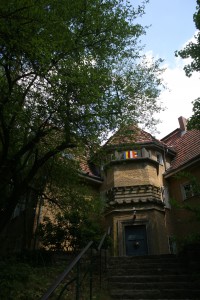
Located in the Berlin suburb of Frohnau, Das Buddhistische Haus (engl. The Buddhist House) is a Buddhist temple complex built in 1924 and therefore the oldest Buddhist temple in Europe. The temple is run by Theravada monks – members of the oldest surviving branch of Buddhism. ‘Theravada’ is a word derived from Sanskrit, and its meaning is ‘The Teaching of the Elders.’ It is considered relatively conservative and closer to early Buddhism than other Buddhist traditions.
The Sanskrit term for a Buddhist monastery, ‘Vihara’ – as Das Buddhistische Haus is today referred to– strongly alludes to the idea of the temple. ‘Vihara’ originally means a ‘secluded place in which to walk,’ and it refers to the ‘dwellings’ or ‘escapes’ to which the wandering monks often retreat during the rainy season. The temple complex in Frohnau today reflects the mindfulness of the early monks. It is a quiet place in which one can rest, reflect on life in a spacious garden decorated with altars and Buddha statutes, or meditate in a beautifully arranged temple.
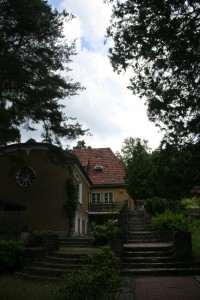
Das Buddhistische Haus was founded by Dr. Paul Dahlke, a Buddhist philosopher and pioneer of Theravada Buddhism in Europe. The temple was purchased from Dr. Dahlke’s heirs in 1957 by the German Dharmaduta Society (GDS), which was founded by Asoka Weeraratna in 1952. It was converted into a Buddhist ‘Vihara’ shortly after the purchase, providing residence to monks from Sri Lanka and elsewhere. Ever since, Das Buddhistische Haus has received a stream of monks wishing to reside there and spread Buddhism in Germany and other European countries. This oldest and largest Theravada Buddhist centre in Europe was even designated as a National Heritage site by the German public authorities.
The temple is nowadays still a permanent residence for a number of Buddhist monks from Asia. However, the previous focus on spreading the Buddha teachings to the masses has shifted after the personnel changes in the German Dharmaduta Society in 2000. Under the leadership of a new manager, Mr. Tissa Weeraratna, nephew of Asoka Weeraratna, The Buddhist House has developed a more educational program in the form of lectures and meditation courses. Life in the House and its activities embody the Theravada Buddha’s teaching. The program is casually structured for visitors, and anyone can interpret the teachings in his or her own way. The temple does not require a membership fee, nor does it require its members to pay the German church tax. Visitors are instead encouraged to make donations of 3 euros for each visit, which is quite reasonable, given that the temple receives no funding from the government or any other external sources.
When planning a visit to Das Buddhistische Haus it might be useful to remember that Mondays are quiet days on which not many visitors or residing monks can be seen. Sundays on the other hand are lecture days on the ways of Buddhism. Meditation courses, depending on the level and the group of disciples, are offered five times a week. While the courses bear a monthly fee, everyone is free to visit and meditate on their own in the Meditation Hall next to the library of carefully selected works on Buddhism and spirituality in general.
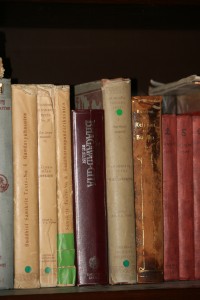
The library of the temple is a restful place with a number of books in Sanskrit, German and English. From religious works about Buddhism, to travelogues on Southeast Asian countries, the library has something to offer to a variety of tastes. It is truly a unique opportunity that one can go there, sit on one of the comfortable couches and read pieces that can rarely be found in regular city libraries – and all that for free. The monks are very friendly in their approach, and any questions one might have can be addressed to them. Luckily, the two monks I encountered there both spoke English, so the language barrier should not be a problem even for those non-German speakers.
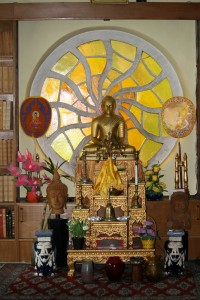
The library also fits into the frame of the overall décor of the temple – one of the most beautiful Buddha statues I have ever seen can be found there, along with an altar on which the visitors can place a lit candle and dedicate a prayer. I consider it a blessing and a true gift that we, the citizens of the highly-populated city of Berlin, have the chance to escape the everyday crowded life and retreat into solitude and our inner being at this unique and quiet spiritual place of the Buddhist monks in Frohnau.
Next to the library is the Meditation Hall, reserved both for the residents of the temple and regular visitors. I was the only person there during my visit, which allowed me a peace of mind without external disruptions for my first meditation in a temple. A large Buddha statue, accompanied by stele bearing some of the Buddhist wisdom in Sanskrit, as well as another altar, give the Meditation Hall a flare of distant lands and hidden teachings, which are in all their mysteriousness still available to all those who wish to partake in them.
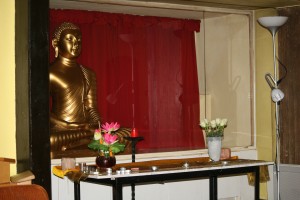
My meditation there bore exactly such a feeling – of traveling and moving through time and space, from Buddha’s time to my current life in Berlin – yet with the sense of perfect wholeness and balance. The peace within is often lost in the daily worries about the passage of time that does not allow us to do all we would ideally wish to. Meditation, on the other hand, can in our minds successfully bring the past, the present – and sometimes even the future – to a unity in which one aspect cannot exist without the other two. And that realization is what provides the feeling of balance and connection with the universe – knowing how everything is connected and interdependent, and that it is alright not to always be in control over different aspects of life.
Das Buddhistische Haus can be an interesting place of exploration for all those with a sense of natural curiosity and an open mind. It is an isolated Buddhist island filled with peacefulness and harmony amidst the lively, exciting and fast-moving city of Berlin. Visiting it made me feel as if I had not only left the central city area, but also the country and the European continent itself. When one is in a reflective and mindful state of existence, Das Buddhistische Haus can be a perfect place to escape to and retain one’s balance and life energy through meditation, reading – or even just sitting in a spacious green garden guarded by miniature representations of the great spiritual teacher Buddha.
Photo gallery:

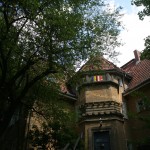


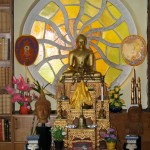

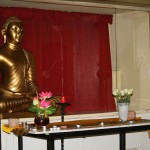
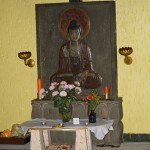
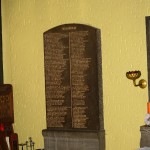


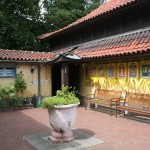
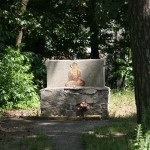

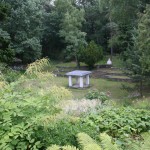


full kindness and compassion should be main base of the any religions, practice with the precepts is the main part of the Buddha’s teaching, purifying mind is the liberation to all sentient being of the universe. happy to see your effort and supports for the eternal peace of the world